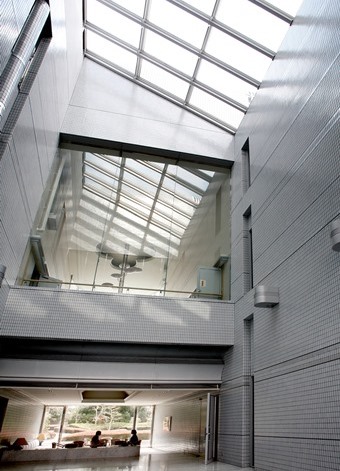Mar. 9, 2014 RIKEN Places Biology Computing / Math
Mimicking living systems
One of RIKEN's newest centers, the Quantitative Biology Center is measuring, modeling and designing living systems to determine the fundamental rules that govern their behavior.
 © 2014 RIKEN
© 2014 RIKEN
Life can be viewed through a paradoxical lens as a large number of nonliving elements cooperating in a network. The rules that govern these networks are perhaps science’s greatest mysteries. Advances in high-resolution imaging, in which Japan is a global leader, have significantly improved our understanding of biological systems. The RIKEN Quantitative Biology Center (QBiC) was established in 2011 to enhance existing technologies and apply them to the most fundamental living unit—the cell—to identify the principles that regulate molecular and cellular networks.
As one of RIKEN’s newest centers, QBiC was envisioned by director and renowned biophysicist Toshio Yanagida to have both an interdisciplinary research and education remit. Mathematicians, biologists and engineers at QBiC work together in 20 laboratories spread across Osaka, Kobe and Yokohama, with easy access to some of RIKEN’s award-winning facilities such as the K computer and SACLA (SPring-8 Angstrom Compact free-electron Laser).
A calculated look
QBiC focuses on three core areas of research: measuring intracellular molecular dynamics, modeling cell behavior and designing artificial systems that recreate biological phenomena. Through close collaboration, QBiC’s Cell Dynamics, Computational Dynamics and Cell Design research teams are developing a holistic understanding of the cell—knowledge that will ultimately contribute to advances in drug discovery and the engineering of energy-efficient technologies, among others.
Laying the groundwork for the collaborative efforts are QBiC’s experimentalists at the Cell Dynamics Research Core, who are developing new imaging and detection techniques to quantitatively measure cellular processes such as transcription and translation as they happen. These include improvements to the spatial and temporal resolution of microscopy for real-time observation of molecules in the cell, synthesis of quantum dot fluorescent probes that emit infrared light for visualizing cellular dynamics in vivo, and the application of mass spectroscopy and nuclear magnetic resonance techniques for analyzing the living cell as a whole.
New measurement tools and the information they generate are helping theorists at QBiC to develop realistic algorithms and models of biological systems. Among other projects, researchers in the Computational Dynamics Research Core are using supercomputers to simulate molecular dynamics at millisecond timescales, as well as to predict the interplay between macromolecules in the cell and the interaction between cells in a tissue or organ.
Engineering biology
With the proliferation of new instruments, measurements and models, synthetic biologists at QBiC are designing artificial systems that mimic their in vivo counterparts from biological components. Current research being performed at the Cell Design Research Core employs multiple strategies such as novel DNA synthesis, genome engineering using artificial restriction enzymes and rapid generation of genetically modified cells, including embryonic stem cells, to ultimately mass produce chimeric mouse models. Discoveries that emerge from these efforts will expand into new branches of the biological sciences, such as protein synthesis, membrane division, spatial and temporal distributions in a cell, and the logic that controls gene networks.
Biological systems seemingly play by a set of impenetrable rules. However, by taking a deeper look at how their various elements co-exist in dynamic environments, QBiC scientists are on course to explaining the invisible order that determines life.
